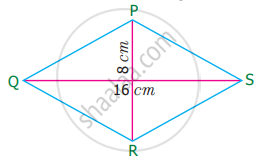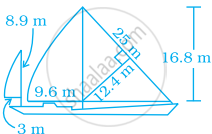Advertisements
Advertisements
प्रश्न
The diagonals of a rhombus are 18 cm and 24 cm. Find:
(i) its area ;
(ii) length of its sides.
(iii) its perimeter
उत्तर
The diagonal of the rhombus is 18 cm and 24 cm.
area of rhombus = `1/2` x Product of diagonals
= `1/2` x 18 x 24
= 216 cm2
(ii)
Diagonals of a rhombus bisect each other at right angles.

∴ OA = `1/2 xx 24 = 12` cm
OB = `1/2 xx 18 = 9` cm
In right ∠d Δ AOB
AB = `sqrt("OA"^2 + "OB"^2)`
= `sqrt((12)^2 + (9)^2)`
= `sqrt(144 + 81)`
= `sqrt(225) = 15` cm
∴ Side of rhombus = 15 cm
(iii)
Perimeter of rhombus = `4 xx "side"`
= `4 xx 15 = 60` cm
(i) 216 cm2 (ii) 15 cm (iii) 60 cm.
APPEARS IN
संबंधित प्रश्न
Lengths of the diagonals of a rhombus are 16.5 cm and 14.2 cm, find its area.
Each side of a rhombus is 18 cm. If the distance between two parallel sides is 12 cm, find its area.
Find the area of rhombus PQRS shown in the following figure.
Find the area of a rhombus whose base is 14 cm and height is 9 cm.
Find the missing value.
| Diagonal (d1) | Diagonal (d2) | Area |
| 26 m | 468 sq.m |
A man has to build a rhombus shaped swimming pool. One of the diagonal is 13 m and the other is twice the first one. Then find the area of the swimming pool and also find the cost of cementing the floor at the rate of ₹ 15 per sq.cm
The figure ABCD is a quadrilateral in which AB = CD and BC = AD. Its area is ______.

Area of a quadrilateral ABCD is 20 cm2 and perpendiculars on BD from opposite vertices are 1 cm and 1.5 cm. The length of BD is ______.
If the diagonals of a rhombus get doubled, then the area of the rhombus becomes ______ its original area.
Most of the sailboats have two sails, the jib and the mainsail. Assume that the sails are triangles. Find the total area of sail of the sailboats to the nearest tenth.

